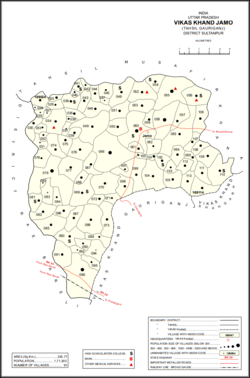Katari, Amethi
Katari
Katāri | |
|---|---|
Village | |
 Map showing Katari (#055) in Jamo CD block | |
| Coordinates: 26°24′13″N 81°41′49″E / 26.403678°N 81.696967°E[1] | |
| Country | |
| State | Uttar Pradesh |
| Division | Ayodhya |
| District | Amethi |
| Area | |
| • Total | 7.115 km2 (2.747 sq mi) |
| Population (2011)[2] | |
| • Total | 6,500 |
| • Density | 910/km2 (2,400/sq mi) |
| Languages | |
| • Official | Hindi, Urdu |
| Time zone | UTC+5:30 (IST) |
Katari is a village in Jamo block of Amethi district, Uttar Pradesh, India.[2] It is located by a stream called the Naiya or Kandu nala, which flows east toward the Gomti river.[3] The main highway from Lucknow to Jaunpur passes further north.[3] Katari was historically the seat of a taluqdari estate held by a leading branch of the Kanhpuria Rajputs.[3]
As of 2011, Katari has a population of 6,500 people, in 1,075 households.[2] It has 4 primary schools and a family welfare centre and it does not host a regular market or weekly haat.[2] It belongs to the nyaya panchayat of Gaura.[4]
History[edit]
At the turn of the 20th century, Katari was described as a large village in the northeastern corner of the pargana of Gaura Jamun.[3] The road to Jamo was of poor quality at the time and was prone to flooding during the rainy season.[3] The population as of 1901 was 2,402 people, including 218 Muslims and a large proportion of Brahmins.[3] Katari served as the seat of a taluqdari estate held by Raja Partab Bahadur Singh, who held 13 villages at the time and was a leading member of the Kanhpuria Rajputs.[3]
The 1951 census recorded Katari as comprising 18 hamlets, with a total population of 2,438 people (1,258 male and 1,180 female), in 539 households and 533 physical houses.[5] The area of the village was given as 1,815 acres.[5] 146 residents were literate, 126 male and 20 female.[5] The village was listed as belonging to the pargana of Gaura Jamo and the thana of Jagdishpur.[5] The village had a district board-run primary school for girls with 91 students in attendance as of 1 January 1951.[5]
The 1961 census recorded Katari as comprising 19 hamlets, with a total population of 2,703 people (1,357 male and 1,346 female), in 581 households and 580 physical houses.[6] The area of the village was given as 1,815 acres and it had a post office at that point.[6] It was also listed as hosting a haat twice per week, on Thursdays and Sundays, mostly dealing in grain and vegetables and having an average attendance of around 100 people.[6]
The 1981 census recorded Katari as having a population of 3,775 people, in 731 households, and having an area of 734.53 hectares.[7] The main staple foods were listed as wheat and rice.[7]
The 1991 census recorded Katari as having a total population of 4,331 people (2,311 male and 2,020 female), in 778 households and 775 physical houses.[4] The area of the village was listed as 735.00 hectares.[4] Members of the 0-6 age group numbered 855, or 20% of the total; this group was 51% male (439) and 49% female (416).[4] Members of scheduled castes numbered 1,364, or 31.5% of the village's total population, while no members of scheduled tribes were recorded.[4] The literacy rate of the village was 34.5% (919 men and 281 women, counting only people age 7 and up).[4] 1,334 people were classified as main workers (1,136 men and 198 women), while 60 people were classified as marginal workers (1 man and 59 women); the remaining 2,937 residents were non-workers.[4] The breakdown of main workers by employment category was as follows: 850 cultivators (i.e. people who owned or leased their own land); 367 agricultural labourers (i.e. people who worked someone else's land in return for payment); 14 workers in livestock, forestry, fishing, hunting, plantations, orchards, etc.; 0 in mining and quarrying; 39 household industry workers; 7 workers employed in other manufacturing, processing, service, and repair roles; 2 construction workers; 9 employed in trade and commerce; 7 employed in transport, storage, and communications; and 39 in other services.[4]
References[edit]
- ^ "Geonames Search". Do a radial search using these coordinates here.
- ^ a b c d e "Census of India 2011: Uttar Pradesh District Census Handbook - Sultanpur, Part A (Village and Town Directory)" (PDF). Census 2011 India. pp. 147–63. Retrieved 17 December 2021.
- ^ a b c d e f g Nevill, H.R. (1903). Sultanpur: A Gazetteer, Being Volume XLVI Of The District Gazetteers Of The United Provinces Of Agra And Oudh. Allahabad: Government Press. pp. 99, 177, 189–90. Retrieved 17 December 2021.
- ^ a b c d e f g h Census 1991 Series-25 Uttar Pradesh Part-XII B Village & Townwise Primary Census Abstract District Census Handbook District Raebareli (PDF). 1992. pp. xxiv–xxviii, 84–5. Retrieved 17 December 2021.
- ^ a b c d e Census of India, 1951: District Census Handbook Uttar Pradesh (49 - Rae Bareli District) (PDF). Allahabad. 1955. pp. 130–1, 199. Retrieved 17 December 2021.
{{cite book}}: CS1 maint: location missing publisher (link) - ^ a b c Census 1961: District Census Handbook, Uttar Pradesh (44 - Sultanpur District) (PDF). Lucknow. 1965. pp. 147, xvi–xvii. Retrieved 17 December 2021.
{{cite book}}: CS1 maint: location missing publisher (link) - ^ a b Census 1981 Uttar Pradesh: District Census Handbook Part XIII-A: Village & Town Directory, District Rae Bareli (PDF). 1982. pp. 42–3. Retrieved 17 December 2021.

